With all the choices of flour on the grocery store shelves, how do we really know if what we’re buying is truly healthy? We want to answer the question, “Is flour bad for you?” so we’re comparing today’s modern flours with ancient varieties to find out which is best and to answer the question, “Is flour healthy?”
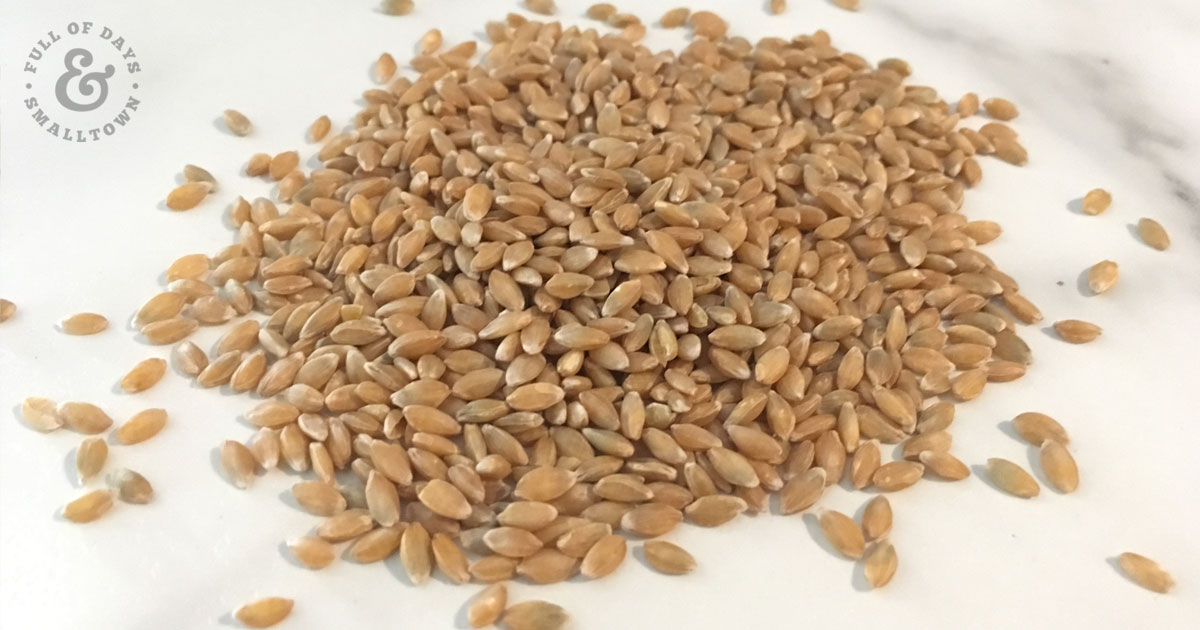
This post was originally published in August 2018 and updated in 2020 for accuracy.
Chances are, if you’ve taken inventory of your health recently, you’ve probably asked yourself one of the following questions, “Is flour bad for me?”, “Should I omit flour from my diet?”, and even “Should I consider going gluten-free?”.
Unfortunately, there’s no “one-size-fits-all” answer. A quick Google search shows results with varying opinions, likely leaving you feeling more confused than when you began your search.
There’s much debate about grains and flour and their health benefits. It’s hard to know whether we should consume them 6-11 times daily (as per the USDA Food Pyramid recommendations), only a few times a day, just a few times per week or never let another grain pass through our lips again!
Truth be told, the answer should be different for each of us, depending on our dietary needs/restrictions and our health concerns/goals.
Is Flour Healthy?
The modern wheat we find on our grocery store shelves (as well as the bleached and unbleached white flour) is a far cry from what our ancestors ate.
Hybridization of wheat goes back longer than I realized, but the problem isn’t with this natural form of hybridization where ancestral grasses in the wild were introduced and cross-pollinated. The problem lies with the chemical hybridization that has occurred in the past 50+ years. In order to create wheat that yields more grain, resists fungal diseases and pest attacks, improves the ease of harvesting (mechanically), and meets the unrealistic demands of industrial milling and mechanized baking methods, science has intervened and it’s our health that’s paying the price.
What are the Differences Between Grain?
Ancient Grain vs. Modern Grain
Ancient grain varieties such as Einkorn (known as a diploid) have just two copies of their 7 chromosomes. The gluten in Einkorn is said to have a completely different effect on the body than the gluten found in our modern-day wheat, possibly the reason why many people with gluten sensitivities can enjoy products made with Einkorn wheat. (More on this below.)
Emmer (a tetraploid grass) has four copies of chromosomes (for a total of 28), compared to Einkorn’s two, and Spelt (a hexaploid wheat variant) has six copies of their 7 chromosomes, for a total of 42. As each new variant of grain was created, the growing conditions became more favorable with less potential for crop failure, exactly what a farmer looking to make a profit would need.
Our modern day wheat (also known as a hexaploid) shares the same ancestry of Spelt, but the hulls are easily removed from the grain kernel. Einkorn, Emmer and Spelt have tough hulls that require quite a bit of effort to remove before the grain can be further processed and consumed as food. This makes modern grain more appealing by large manufacturers as the production of flour is quicker, easier and therefore, less expensive. Modern wheat has evolved over the years as farmers select seeds at harvest time which suit the goal of higher yields and more gluten. (Source, Source)
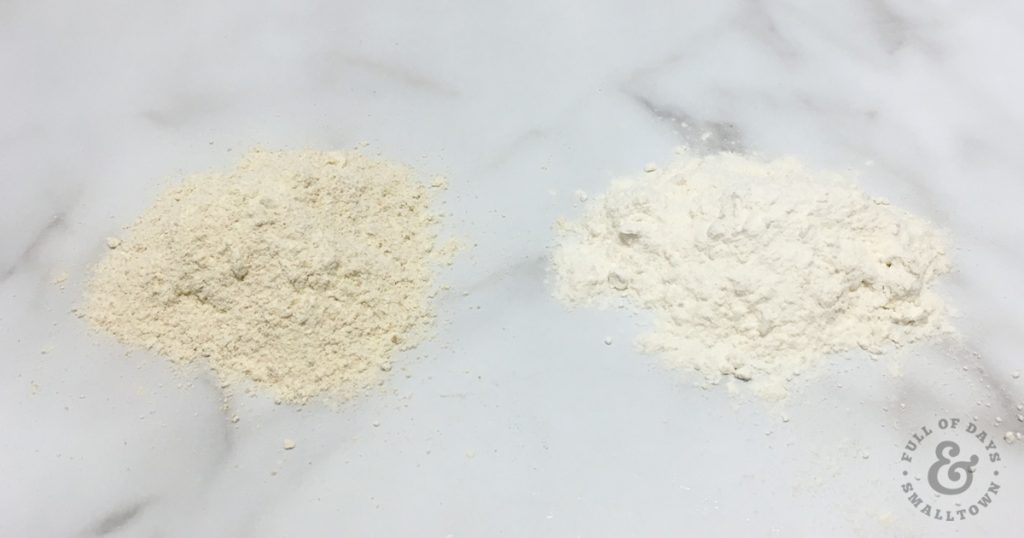
Whole Wheat vs. White Flour – What are the Differences?
Just a quick glance tells you there’s quite a difference between whole wheat flour and white flour (whether bleached or unbleached). Looking at the picture at the top of this post, it’s obvious to see. This is freshly milled Einkorn grain next to organic unbleached, white all-purpose flour.
But what other differences are in the flours that aren’t noticeable by the naked eye?
Whole wheat flour is made by grinding the entire grain (bran, germ and endosperm). White flour is only comprised of the endosperm. Modern technology has allowed the grain to be separated in order to obtain a longer shelf-life for white flour.
How a Healthy Grain Becomes an Unhealthy Grain
Once grain or wheat berries are ground into flour, the nutrients are “on the clock” and only have so long before they expire.
Why does this happen?
Within each tiny grain, there are three parts, bran, endosperm, and germ. The bran is the outer layer and rich in fiber. The endosperm makes up the bulk of the kernel (this is the part used to make white flour) and contains vitamins and minerals. The germ is the inner layer which is rich in nutrients and contains healthy oils.
When grain is ground, the germ, which contains oils, is mixed throughout the flour. This oil has a fairly short shelf-life before going rancid and changing not only the flavor of the flour, but the nutritional quality as well. We’ll discuss this more later on, but I like to follow this general rule of thumb:
How to Store Freshly Ground Flour:
- If stored at room temperature – use within three days of grinding.
- If stored in the refrigerator – use within one to two weeks of grinding.
- If stored in the freezer – use within one month of grinding.
As you can see, flour has quite a short shelf-life before losing most of its nutrients and becoming rancid. The reason bleached white flour has such a long “shelf-life” at the grocery store, is the healthiest parts of the grain have been removed, preventing the rancidity from the oils. But this comes at a cost. The flour is now much less nutritious, and it’s no longer a “whole food”.
Grain was created in such a way that each part of the grain has a purpose. When certain parts are removed, the product immediately becomes less healthy. In the case of grain, when the bran and germ are removed, it will “live” longer on the shelf, but you’ve just removed vital nutrients and important fiber that helps our body absorb the nutrients slowly, helping us feel fuller, keeping us regular and overall, healthier.
Grinding Your Own Grain
If you’ve ever looked into buying healthier, whole-wheat flours, you’ll notice the cost per pound increases as the quality of the grain improves. Buying pre-ground Einkorn flour can quickly become cost-prohibitive, especially for large families who enjoy bread and other baked goods on a regular basis. But again, with the information above, how do we know how “fresh” this flour is? Does the package list a “milled-on-date”? Likely not. So to be sure we’re getting the freshest flour possible, we’re probably going to need to grind it ourselves.
Luckily, if you buy the whole grain, you’ll be able to buy much higher quality grains for less than the whole ground flour. BUT, you will need some special equipment to make this happen. I won’t get into this too much now (we’ll delve deeper into the best equipment for grain-grinding in another post), but our family has tried multiple grain-grinding options and we’re the happiest with our Mockmill Grain Mill.
The Mockmill is compact and sits on our countertop. It’s quick, fairly quiet (quieter than the blender, anyway!), and makes eating freshly ground grain a snap. Basically, instead of measuring out a cup of flour for a recipe, I measure out about 1/2 cup grain, toss it in the mill, and about a minute later, have freshly ground flour to bake with.
To be honest, I was a skeptic when it came to grinding my own grain. I really didn’t think the taste would merit the cost of a grain mill. So to test it out, we started by grinding grain in our dry blade canister that came with our Vitamix. Y’all won’t believe me that the taste of freshly milled grain is so different than store-bought, it tastes so fresh, nutty and almost sweet…it’s just one of those things you have to taste for yourself!
But I found the Vitamix always left my grain super hot and I’d have to let it cool off before using it in recipes (not super convenient, and also, probably not so good for the grain?), that’s why I was thrilled that the grain came out just slightly warm after running through the Mockmill (it was also quite a bit finer).
Which Flour is the Healthiest?
If your diet allows for grains/flour, then the healthiest choice is Einkorn as it’s the most ancient grain available. It boasts nutritional benefits like higher protein, iron, dietary fiber, thiamine, B Vitamins, and other essential dietary and trace minerals. It also contains a significant amount of the powerful antioxidant Lutein. Not only that but during processing, Einkorn loses a lower percentage of nutrients than other grains.
But don’t limit yourself to Einkorn only…experiment with other grains and see which fit into a healthy balanced diet for you and your family. We LOVE using freshly milled Spelt for making homemade graham crackers, and we’ve found quite a few amazing honey-wheat sandwich bread recipes that use a combination of hard red wheat and soft white wheat berries, too. Einkorn is incredible for delicious, hearty treats like homemade coffee cake…and I find using a mixture of grains (including organic, unbleached white flour!) yields the best results for homemade sourdough bread.
Below is a chart from the USDA National Nutrient Database for Standard Reference, unfortunately, the chart doesn’t include Einkorn. But it’s worth seeing just how nutritious (properly prepared) grain can be as part of a well-balanced diet. This chart is showing the nutritional content of the grain in its whole form.
What Makes Einkorn Better?
As mentioned above, Einkorn is made up of only two sets of 7 chromosomes. Surprisingly, it also has a completely different type of gluten than modern day wheat. To get super geeky…genome mapping of this wheat has shown that it contains a small chain of peptides found within the third set of chromosomes that seems to be the culprit of celiac disease.
Because Einkorn only has two sets, these peptides are not present, potentially making Einkorn OK for those with gluten-intolerances. (Read more about this here. And as always, do your own research and consult a physician if you suffer from gluten-intolerances/celiac disease.)
Whole-Grain Flour vs. White Enriched Flour
Keeping in mind what we’ve already discussed above, let’s look a little closer at that enriched white flour found on the grocery store shelf.
- The process of making white flour starts when the germ and bran are processed out of the flour. This means the flour has less fiber and has basically become pure starch.
- Enriched white flour is digested much faster than whole grain, typically resulting in a blood-sugar spike. Whole grains are digested slowly due to the high fiber and protein, this results in you feeling full for a longer period of time and more stable blood-sugar levels. Whole grains are not processed as a starch, so they don’t throw your body into a sugar dependency cycle.
- The term “enriched” white flour is deceiving. The nutrients that are added back in to “enrich” the flour are synthetic forms of what was stripped away during processing. These nutrients are unrecognizable and therefore, unusable by our bodies. Whole grain foods have more nutrients, period.
How do I Make Flour More Digestible?
There are three simple, yet sometimes time consuming, methods to make whichever flour you’re consuming more digestible (and more nutritious). But don’t let the time scare you. You can quickly work these methods into your daily routine without really adding much time at all (since most of the time-consuming part is purely hands-off).
- Soaking – This is where you soak your flour with an acidic medium (yogurt, kefir, water mixed with lemon juice or apple cider vinegar, etc.) for 8-12 hours to neutralize the phytic acids and increase nutrients for easier digestion.
- Sprouting – By sprouting grain before milling it you can achieve the same results of neutralizing phytic acids and increasing nutrients. The process of sprouting is where you soak your grain in water, then rinse it daily until tiny sprouts grow out of your grain. You can then dehydrate the grain and grind as needed for recipes.
- Souring (Fermenting) – This is my favorite method and the method used anytime you’re following a traditional sourdough recipe. By using wild yeast (sourdough), you allow the microorganisms to essentially pre-digest the grain as it sits on your counter for 6-8 hours.
What Next?
Y’all have heard us say it before (and we’ll keep repeating it until we’re blue in the face), we’re huge proponents of the “Good, Better, Best” motto. This means, if you’re buying bleached, non-organic white flour at the grocery store…something you could do to make that better might be to buy an organic variety of unbleached white flour. This will act the same in all your favorite recipes, without you having to get used to baking with whole grains, but you won’t be exposed to the harmful pesticides used in non-organic farming practices.
Perhaps you’re already using organic white flour…that’s good! For you, better might be swapping it out with organic whole wheat, or even subbing up to half the flour in a recipe with whole wheat to add more nutrition.
My point here is we don’t all need to worry that we’re not doing enough to feed our family healthy food. But what I suggesting you ask yourself is, “what change can I make to do better?”
For us, the progression looked like this:
- Swapped non-organic bleached, all-purpose white flour for non-organic whole wheat flour.
- Swapped non-organic whole wheat flour for organic, unbleached all-purpose white flour.
- Started incorporating up to 1/2 freshly milled organic wheat berries (milled using our Vitamix Dry Blade canister) into some of our recipes and incorporated some soaking methods occasionally.
- Started converting most of our recipes into sourdough recipes by soaking our flour for 6-8 hours (or overnight) before baking.
- Started milling our own Einkorn wheat berries using the MockMill100 and incorporating 50-100% of the flour into our sourdough recipes.
As you can see, it’s been a journey! And this was over the course of 8 years!
What About You?
Where are you in your “Good, Better, Best” journey? Do you have questions you’d like answered to help you make healthier choices for you and your family regarding grain and flour?
Ask us in the comments below and we’ll be sure to share our best tips!
- Our referral links are above. If you click through and take action, we may be compensated. Our full disclosure is here.


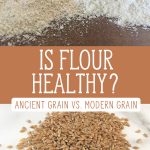


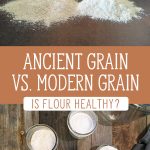

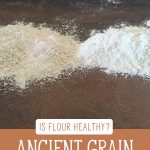




Hi Kelsey, great post. I’d like to get your take on the following. Thanks in advance.
https://www.amazon.com/Jovial-Organic-Einkorn-Whole-Wheat/dp/B07FMR28WP
Hi Sugi! Great question! As far as buying flour goes, this will be your best bet. However, once the grain is ground it starts losing its nutritional value rapidly and can go rancid quickly. It’s always best to buy the whole grain and grind it yourself, but if that’s not an option, Jovial is a fantastic company and they would be at the top of my flour buying recommendations list.
I also use Einkorn flour, and my starter is from Einkorn but I never have 2 cups at one time, let alone have some left over.
So would your recipe yeld 2 plus cups?
I’m sorry Lynne… for what recipe are you talking about? This comment was left on the post “Is Flour Bad for You?” and I don’t have a recipe on that page! Let me know what recipe you’re referring to and hopefully I can help!
Great post! Thank you!
I wondered about coconut flour though. My understanding it that coconuts do not have the same concerning phytates as grains. Does the coconut flour on a grocery shelf have less nutrients that freshly made? How do you make coconut flour?
Great question Alisha! You’re absolutely right, coconut flour doesn’t have the same concerns because it’s not really “flour” at all, it’s fruit! However, sourcing an organic, high quality brand IS important. We recommend Nutiva brand, which can be found in many grocery stores or on Amazon. I’ve never made coconut flour before, but I’m sure if you did a quick google search you’d find out how! 🙂
I really think that freshly ground flour fermented over a long period of time produces the easiest-to-digest end product. It’s probably not a coincidence that that is how bread was made for a very long time, up until industrialism really took hold.
I am also a huge fan of heirloom grains and am really enjoying gluten-free sourdough breads at the moment.
What a great resource! Thanks for putting all this info together, Kelsey. We’ve been grinding our own organic hard red wheat berries for years now, and our starts love it! If I accidentally run out and have to go buy regular whole wheat flour from the store, my starter throws a fit. Haha.
I think you’re right on “there’s no one size fits all”! Everyone kind of has their own journey. Personally, we use a lot of nut flours in place of regular flour or my favorite grains (like oats and quinoa).
It’s too bad you’ve limited this discussion to these three wheats when there are other heritage varieties that bake much lighter I.e. Turkey Red and Red Fife among others. A diploid actually has 14 chromosomes, 2 sets of 7 from each parent. Spelt has 46. We have kept dry milled whole wheat on the shelf for over a year and it’s never gone rancid, surely never in as short a time as 3 days.
Marty, we appreciate your reply, and thanks so much for catching our typo on the chromosomes! I mistakenly left out that they are “sets” of chromosomes, so you’re right about the number as each set contains 7 chromosomes! As for leaving out different varieties of wheat, it wasn’t our intention to limit our readers, which is why we said, “But don’t limit yourself to Einkorn only…experiment with other grains and see which fit into a healthy balanced diet for you and your family.” These are simply the varieties we’ve had personal experience with! I would love to see some documented test results of flour that hasn’t lost nutrients or become rancid or oxidized after an entire year! If you can point me to them, please do! Thanks again for your comment!
Please tell me more about all the supplements added to flour and why it should be there ???
Great question Estelle! Please note that not all flour has been “enriched” or “fortified”. It should say on the bag. But the process of making white flour strips the grain of so many nutrients, this is why flour is “enriched” or “fortified” with certain nutrients. To the consumer, that makes us happy to see these things added back in. But adding in these nutrients is never a substitute for the nutrient in its natural form. Often these are synthetic and unusable by our body. Also, nutrients aren’t added back in at the same ratio as the original grain contained. Furthermore, not all nutrients are added back in, or some nutrients are added in larger quantities (like iron). It’s these different ratios that can be harmful to our bodies since the grain contains vitamins and minerals in ratios that work together within the body for proper absorption and digestion. When this balance is messed with, it makes it difficult on our body. Here’s a really great post about enriched flour if you want more info!